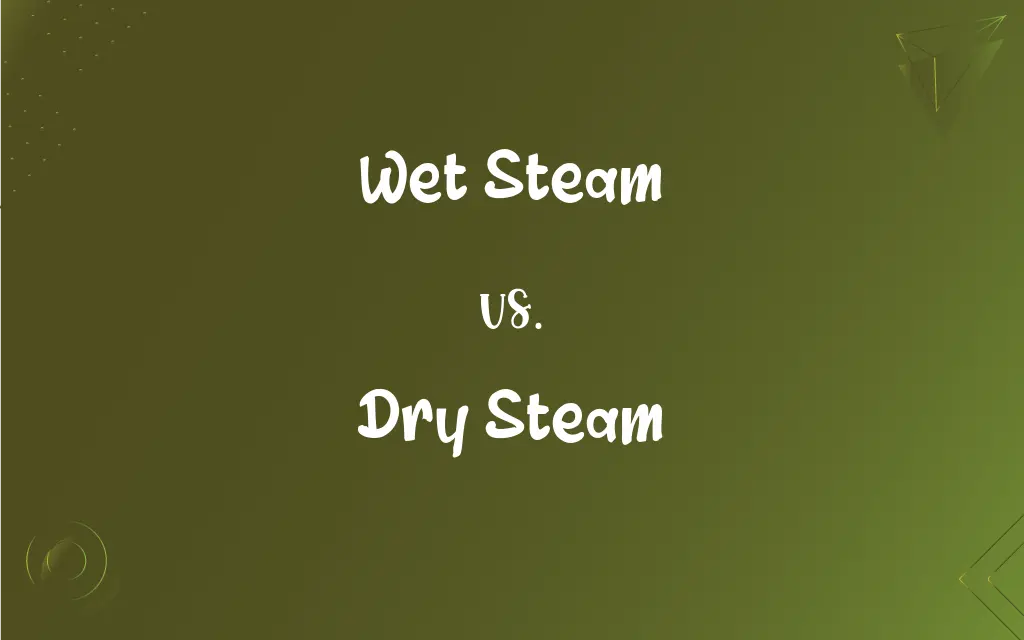Wet Steam vs. Dry Steam: What's the Difference?
Edited by Aimie Carlson || By Janet White || Published on March 31, 2024
Wet steam contains water droplets within it, whereas dry steam is fully vaporized without water droplets.

Key Differences
Wet steam is steam that contains water droplets suspended within it. This state occurs when the steam has not absorbed enough energy to convert all the water into a vapor state. As a result, wet steam is not as efficient in energy transfer processes because the water droplets can reduce the steam's temperature and energy content. Dry steam, in contrast, is steam that has been heated beyond the boiling point of water under its pressure conditions, allowing it to exist in a fully vaporized state without any suspended water droplets.
The presence of water droplets in wet steam can lead to inefficiencies and potential damage in turbines and other machinery, as the droplets can cause erosion and decreased efficiency. Dry steam's absence of water droplets makes it ideal for use in turbines and other sensitive equipment, where maximizing efficiency and minimizing wear are critical.
Wet steam's lower temperature and energy content compared to dry steam make it less suitable for applications requiring high thermal energy, such as industrial processes and electricity generation. Dry steam's higher temperature and purity make it highly sought after for these applications, providing more power and efficiency.
The quality of steam is often measured by its dryness fraction, which indicates the proportion of steam in a mixture of steam and water. Wet steam has a lower dryness fraction, indicating a higher presence of water droplets, whereas dry steam has a dryness fraction close to 1, indicating it is almost entirely vapor.
Comparison Chart
Composition
Contains water droplets in the vapor.
Completely vaporized without water droplets.
ADVERTISEMENT
Energy Efficiency
Less efficient due to the presence of water droplets.
More efficient as it is fully vaporized.
Application
Less suitable for turbines and sensitive machinery.
Ideal for turbines and high-energy applications.
Temperature and Energy
Lower temperature and energy content due to water droplets.
Higher temperature and energy content, fully utilizes heat.
Dryness Fraction
Lower dryness fraction, indicating higher water content.
Higher dryness fraction, close to 1, indicating pure vapor.
Wet Steam and Dry Steam Definitions
Wet Steam
Wet steam is characterized by a mixture of water and vapor.
In the steam room, you could see the wet steam clinging to the walls.
ADVERTISEMENT
Dry Steam
Dry steam is used in turbines for electricity generation.
The power plant utilizes dry steam for maximum efficiency.
Wet Steam
Wet steam is a phase of steam with incomplete vaporization.
Wet steam is less efficient for driving turbines.
Dry Steam
Dry steam results from heating water beyond its boiling point.
Dry steam vents are a sign of an active geothermal field.
Wet Steam
Wet steam results from insufficient heating of water.
The old radiator emitted a gentle hiss of wet steam.
Dry Steam
Dry steam is steam with a high dryness fraction.
Dry steam is preferred for industrial cleaning due to its high energy content.
Wet Steam
Wet steam is steam at a lower energy state than dry steam.
Wet steam can cause erosion in steam engine components.
Dry Steam
Dry steam is fully vaporized steam without water droplets.
The dry steam from the geothermal plant powered the turbines efficiently.
Wet Steam
Wet steam is steam that contains water droplets.
The wet steam from the boiler made the room feel more humid.
Dry Steam
Dry steam has higher thermal energy than wet steam.
Dry steam provides more efficient heating in residential systems.
FAQs
How is dry steam generated?
Dry steam is generated by heating water until all of it vaporizes into steam, with no water droplets remaining.
What is dry steam?
Dry steam is steam that is fully vaporized, without any water droplets.
Can wet steam damage machinery?
Yes, the water droplets in wet steam can cause erosion and damage to machinery over time.
How can you measure the quality of steam?
The quality of steam is measured by its dryness fraction, indicating the proportion of vapor to water droplets.
Why is dry steam preferred over wet steam for turbines?
Dry steam is preferred because it doesn't contain water droplets that can erode turbine blades.
What applications are suitable for wet steam?
Wet steam is suitable for applications where complete dryness is not critical, such as certain heating processes.
How is wet steam produced?
Wet steam is produced when water is heated but not all of it turns into vapor, leaving some water droplets.
What is wet steam?
Wet steam is steam containing water droplets within it.
What is the dryness fraction of ideal dry steam?
The dryness fraction of ideal dry steam is close to 1, indicating pure vapor.
Is wet steam or dry steam more efficient for heating purposes?
Dry steam is more efficient as it transfers heat more effectively due to its fully vaporized state.
What makes dry steam ideal for electricity generation?
Its high energy content and ability to efficiently transfer heat make it ideal for driving turbines.
Does wet steam have any advantages?
Wet steam can be advantageous in applications requiring moisture, such as certain humidification processes.
What are the safety concerns with handling dry steam?
Handling dry steam requires caution due to its high temperature and pressure.
Can the presence of wet steam affect thermal efficiency?
Yes, wet steam's lower temperature and energy content can reduce thermal efficiency.
What is the significance of the dryness fraction in steam systems?
It helps determine the efficiency and suitability of steam for various applications.
How does the presence of water droplets in wet steam impact heat transfer?
Water droplets can reduce the efficiency of heat transfer by absorbing some of the energy.
How do you convert wet steam to dry steam?
Increasing the heat or decreasing the pressure can help vaporize the water droplets, converting wet steam to dry steam.
Can dry steam carry more heat than wet steam?
Yes, dry steam can carry more heat due to its higher temperature and lack of water droplets.
Can wet steam be used in food processing?
Yes, wet steam is sometimes used in food processing where moisture is needed.
Is it possible to have 100% dry steam?
In practical applications, achieving 100% dry steam is challenging, but it can be very close to fully vaporized.
About Author
Written by
Janet WhiteJanet White has been an esteemed writer and blogger for Difference Wiki. Holding a Master's degree in Science and Medical Journalism from the prestigious Boston University, she has consistently demonstrated her expertise and passion for her field. When she's not immersed in her work, Janet relishes her time exercising, delving into a good book, and cherishing moments with friends and family.
Edited by
Aimie CarlsonAimie Carlson, holding a master's degree in English literature, is a fervent English language enthusiast. She lends her writing talents to Difference Wiki, a prominent website that specializes in comparisons, offering readers insightful analyses that both captivate and inform.
































































